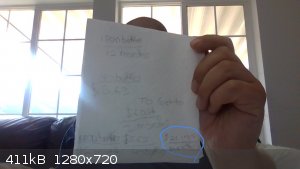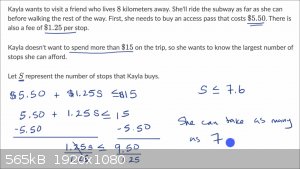Yttrium2
Perpetual Question Machine
    
Posts: 1104
Registered: 7-2-2015
Member Is Offline
|
|
Water Filter Savings - Math Help
Got a new water filter, it was $20
Makes all the difference in flavor, I'm guessing this is a result of different mineral profile'
Thats the start of a new question-
But,
Lets say that the water filter / pitcher is $20, it lasts 2 months, and saves 300, 16.9 fl oz water bottles every 2 months. The filter costs $7.50--
There is a pack of 40 count - 16.9 fl oz bottles for $5.63
so I do
300/40 = 7.5 -- (Not sure what my units are here but I do this kind of intuitively, if someone could point that too out)
then I do --
7.5 x 5.63 and I get 42.25
then I subtract the cost of the water filter, 42.225 - 20
I get 22.225
then I subtract the cost of a filter, 22.225 - 7.50 -
I get 14.725
$14.725 USD --
Do I round up or down when dealing with savings? There is that 5/1000th of a dollar that is troubling me.
[Edited on 6/14/2023 by Yttrium2]
|
|
|
B(a)P
International Hazard
    
Posts: 1139
Registered: 29-9-2019
Member Is Offline
Mood: Festive
|
|
What about the cost of the water?
Cost of disposal of the filters?
Environmental costs of manufacturing?
Where are the filters made, have you checked the supply chain to make sure you are not supporting modern slavery?
Seriously though, it is pretty hard to work out what you are doing if you can't provide the units. What is the '300' you are saving?
If you want to find out if you are financially better of, compare what you were spending on bottled water per month to the cost of the filter per
month. You are not wrestling with tax law here, you are the only person that can decide how accurate you want to be, ie how much to round.
|
|
|
Rainwater
National Hazard
   
Posts: 919
Registered: 22-12-2021
Member Is Offline
Mood: indisposition to activity
|
|
Im going to explain this using different products, the amounts will be different from your homework but the process is identical.
First understand that is is a multi step problem.
To calculate the savings, you have to know the cost difference between your options.
In this case, filtering water or bottled water.
The easiest method is to convert the cost analysis down to the most basic unit.
Price per 1 fl oz.
Using this bottled water you get 33.8 ounces for $115.65
I use word problems to discover what the math looks like.
You want to know the dollars per ounce.
115.65 ÷ 33.8 = 3.42 per ounce.
I will be using the details provided by this product for the filters
By remove the capital investment for the appratus and focusing solely on the cost of consumables (water and filters) a good estimate for the "cost of
operation" can be obtained.
Figuring out what your tap water cost per ounce is the hardest part
Just so happens im reviewing my water bill, now im sad
1 unit of water is 1000 gallons or 128,000 ounces
Unit price is based on a tier schedule.
Explaning that will put me into tears,
so lets assume that each unit is in tier 1 and cost $14.73.
You want to know the dollars per ounce.
That becomes
Dollars ÷ ounces or 14.73 ÷ 128000 or 1.15×10-4
Each filter comes in a 6 pack and cost $20.99 per pack.
You want to know the dollars per filter.
20.99÷6 = $3.50 per filter
Each standard filter is good for 40 gallons (assuming US gallons)
Gallons to ounces is 1:128, so
40×128= 5120oz per filter
Each filter can process 5120oz.
Again, you want to know the dollars per ounce.
The cost of a filter divided by how much it can process.
3.50 ÷ 5120 = 6.83×10-4
By adding the cost of water per ounce, to the cost of the filter per ounce, the total cost of filtering is
1.15×10-4 + 6.83×10-4 = 7.98×10-4 per ounce
7.98×10-4 per ounce
To compare the two, its simple division. Start with the larger value. In this case, the bottled water.
The bottled water cost "blank" more than the filtered.
3.42 ÷ 7.98×10-4 = 4286.
"You can't do that" - challenge accepted
|
|
|
Yttrium2
Perpetual Question Machine
    
Posts: 1104
Registered: 7-2-2015
Member Is Offline
|
|
Since ya can't have $14.725 USD its got to go to a whole cent, no fractions of a cent... I just don't know if it goes up or down, when dealing with
savings like in this scenario
I suspect it goes to $14.72 USD

[Edited on 6/14/2023 by Yttrium2]

|
|
|
Yttrium2
Perpetual Question Machine
    
Posts: 1104
Registered: 7-2-2015
Member Is Offline
|
|
Quote: Originally posted by B(a)P  | What about the cost of the water?
Cost of disposal of the filters?
Environmental costs of manufacturing?
Where are the filters made, have you checked the supply chain to make sure you are not supporting modern slavery?
Seriously though, it is pretty hard to work out what you are doing if you can't provide the units. What is the '300' you are saving?
If you want to find out if you are financially better of, compare what you were spending on bottled water per month to the cost of the filter per
month. You are not wrestling with tax law here, you are the only person that can decide how accurate you want to be, ie how much to round.
|
Solve the problem with the given information.
300 was the amount of 16.9 fluid ounce water bottles.
I'm trying to find out what to do with the 5/1000th's of a dollar in my calculation, that is all.
|
|
|
B(a)P
International Hazard
    
Posts: 1139
Registered: 29-9-2019
Member Is Offline
Mood: Festive
|
|
So you are asking about rounding?
The rule is that if the last number is 5 or greater you go up, 4 or less down.
So 1.235 goes to 1.24
and 1.234 goes to 1.23
|
|
|
Yttrium2
Perpetual Question Machine
    
Posts: 1104
Registered: 7-2-2015
Member Is Offline
|
|
Quote: Originally posted by B(a)P  | So you are asking about rounding?
The rule is that if the last number is 5 or greater you go up, 4 or less down.
So 1.235 goes to 1.24
and 1.234 goes to 1.23 |

Do you see why they rounded down here?
She could afford to go 7 stops.
Technically, 7 and 6/10th's of a stop, but stops come one at a time, so the furthest she could travel, was 7 stops.
[Edited on 6/14/2023 by Yttrium2]
|
|
|
Sulaiman
International Hazard
    
Posts: 3695
Registered: 8-2-2015
Location: 3rd rock from the sun
Member Is Online
|
|
For rounding of digits,
just think of negative numbers as
a mirror image of positive numbers,
on a scale.
The litres/filter (fl.oz./dollar)
will strongly depend upon the quality of water supplied to the filter.
So precision is irrelevant in this case
CAUTION : Hobby Chemist, not Professional or even Amateur
|
|
|
j_sum1
Administrator
       
Posts: 6321
Registered: 4-10-2014
Location: At home
Member Is Offline
Mood: Most of the ducks are in a row
|
|
The cost of the water itself is negligible in this case.
You say that your filter saves 300 bottles.
Option 1 -- using filtered water
Cost = $20
Option 2 -- using bottled water
Calculate the cost of 300 bottles
Really, it could not be simpler.
|
|
|
Johanson
Harmless

Posts: 39
Registered: 23-3-2023
Member Is Offline
|
|
No no, this is all wrong:
You buy the pitcher and the filter for $27.50 online, using your wife's credit card... "honey aren't I so thoughtful bla bla bla"
Then your own offspring and all the useless neighborhood kids drink all the filtered water, give it to the dog, yada yada, so the pitcher is
constantly empty right when you need a drink coming in from mowing the lawn, pumping the septic tank, etc etc.
Then some knucklehead... most likely brother-in-law... tries French-pressing coffee through the thing, destroys the filter, and leaving a huge mess.
Fed up, you return the thing to Amazon, who refuses to refund your money, pssing off wife and everyone else.
Final Analysis:
Investment: $27.50 plus tax
Savings: $10 in bottled water
Return on Investment: -64 percent
[Edited on 15-6-2023 by Johanson]
|
|
|
BromicAcid
International Hazard
    
Posts: 3247
Registered: 13-7-2003
Location: Wisconsin
Member Is Offline
Mood: Rock n' Roll
|
|
You said it in your opening post - makes all the difference in terms of flavor. Sounds like it's already worth the investment.
My wife and I drink RO water - I know, I know - not the healthiest thing in the world but we both love the flavor (or lack thereof). We swap out
filters every 12 months for the carbon/sediment and the RO filter every 18 months. Before this we were buying 1 gallon jugs from Walmart, three a
week so $3/week. Once the system was in place then it was just the upkeep on the filters which worked out to $0.71/week. The system paid for itself
in the first year.
|
|
|
Neal
Hazard to Others
  
Posts: 143
Registered: 24-12-2021
Location: Chicago, IL, USA.
Member Is Offline
|
|
I have a side question.
The filter inside has activated carbon, and basically other rocky things.
If you put in water, should the water level always be below the bottom of the filter? Because if you go above it, the water could be in constant touch
with the activated carbon and such.
|
|
|
BromicAcid
International Hazard
    
Posts: 3247
Registered: 13-7-2003
Location: Wisconsin
Member Is Offline
Mood: Rock n' Roll
|
|
The activated carbon filter should only adsorb non-water components, direct contact shouldn't reduce the lifespan. Note for example whole house water
filters are left perpetually submerged in water during their course of use (water only flows when needed).
|
|
|
Neal
Hazard to Others
  
Posts: 143
Registered: 24-12-2021
Location: Chicago, IL, USA.
Member Is Offline
|
|
Quote: Originally posted by BromicAcid  | | The activated carbon filter should only adsorb non-water components, direct contact shouldn't reduce the lifespan. Note for example whole house water
filters are left perpetually submerged in water during their course of use (water only flows when needed). |
So when the non-water is stuck to the activated carbon, I'm worried that raising the water level to it, can cause the components to bond away from the
activated carbon and back into the waterstream it goes. So don't we want the activated carbon to be dry?
|
|
|
Neal
Hazard to Others
  
Posts: 143
Registered: 24-12-2021
Location: Chicago, IL, USA.
Member Is Offline
|
|
Do water filter pitchers, help absorb PFAS?
The chemical and manufacturing giant 3M reached a $10.3 billion settlement on Thursday with U.S. cities and towns over their claims that the company
contaminated drinking water with so-called forever chemicals used in everything from firefighting foam to nonstick coatings. Under the sweeping
settlement, 3M said it would pay out the money over 13 years to any cities, counties and others across the country to test for and clean up
perfluoroalkyl and polyfluoroalkyl substances, known as PFAS, in public water supplies. 3M, which is facing about 4,000 lawsuits by states and
municipalities for PFAS contamination, did not admit any liability.
|
|
|